Welcome to the chill, mysterious realms of the Arctic, where the coffee’s always iced and the locals wear blubber. Yeah, you heard that right. In these icy waters, the walrus reigns supreme, not just as a magnificent marine mammal but as a creature of fascinating habits, quirks, and—dare I say—a bit of an underwater trendsetter.
What is the Walrus?
Imagine a creature so intriguing that it looks like it swam straight out of a fantasy novel, tusks and all. That’s the walrus for you—part whiskered wonder, part marine heavyweight, and entirely fascinating. Scientifically known as Odobenus rosmarus, the walrus is a large flippered marine mammal with a presence in the Arctic Circle’s chilly waters.
These creatures are divided into two subspecies: the Pacific walrus, which hangs out in the Bering Strait and surrounding areas, and the Atlantic walrus, spotted from Canada to Greenland. But don’t let their rugged exterior fool you; walruses play a crucial role in their marine ecosystem, acting as both predator and prey, maintaining the delicate balance of their chilly home.
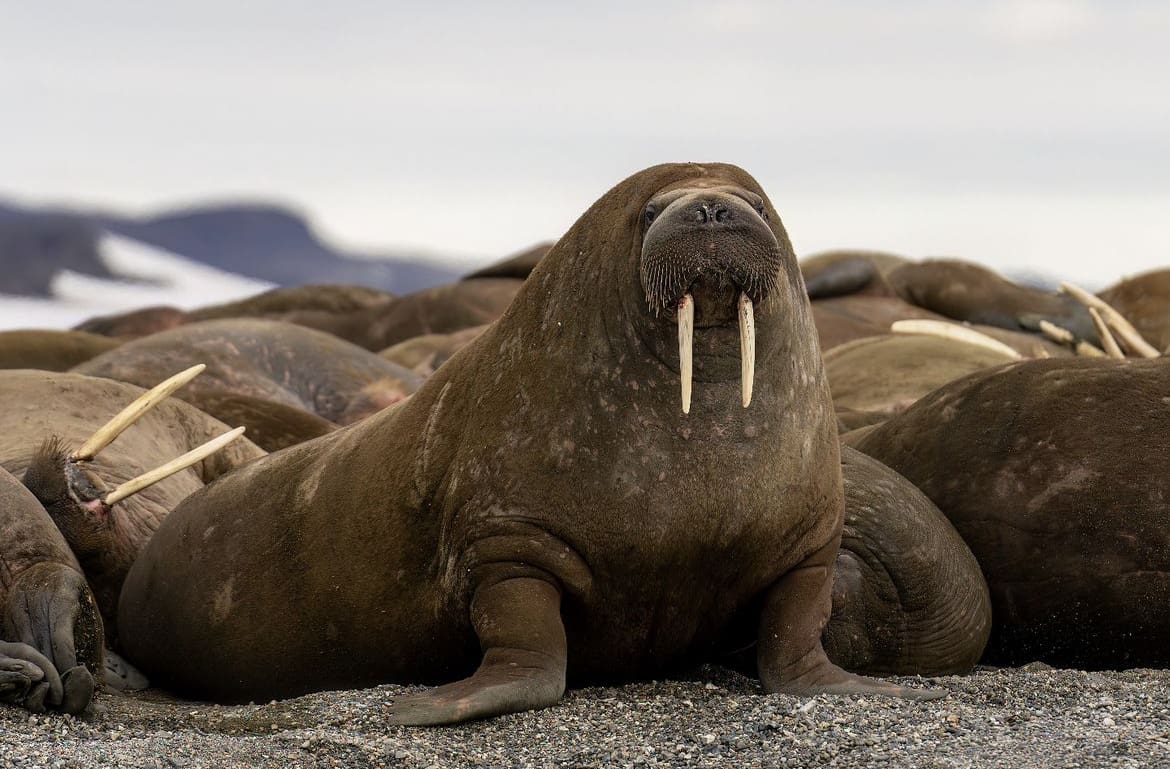
What do Walruses Look Like?
Now, if you’re picturing a large, somewhat awkward animal with a pair of impressive tusks. And you wouldn’t be wrong. Walruses are indeed massive, with a thick skin that looks like it’s been designed for the ultimate polar plunge. They’re equipped with a set of must-have accessories for the Arctic lifestyle: long, bristly whiskers, known as vibrissae, and flippers that could make any swimmer envious.
These whiskers aren’t just for show; they’re super sensitive, helping walruses detect their next meal on the dark ocean floor. And those flippers? They’re not just for swimming; walruses use them to haul their hefty bodies onto ice floes, showcasing a blend of power and grace that would put any ballet dancer to shame.
How Big are Walruses?
When it comes to size, walruses don’t mess around. Adult males, known as bulls, can tip the scales at up to 1,500 kg (about 3,300 lbs), making them the undisputed heavyweights of the Arctic. They grow up to 3.6 meters (nearly 12 feet) long, which means they take up more space than a small car. Females, or cows, are slightly more petite, if you can call weighing around 1,250 kg (2,760 lbs) petite.
This size isn’t just for show; it’s a crucial adaptation to their cold environment, providing the insulation and energy reserves needed to survive in one of the planet’s most unforgiving habitats. So, next time you’re feeling a bit out of shape, just remember: in the walrus world, bigger is definitely better.
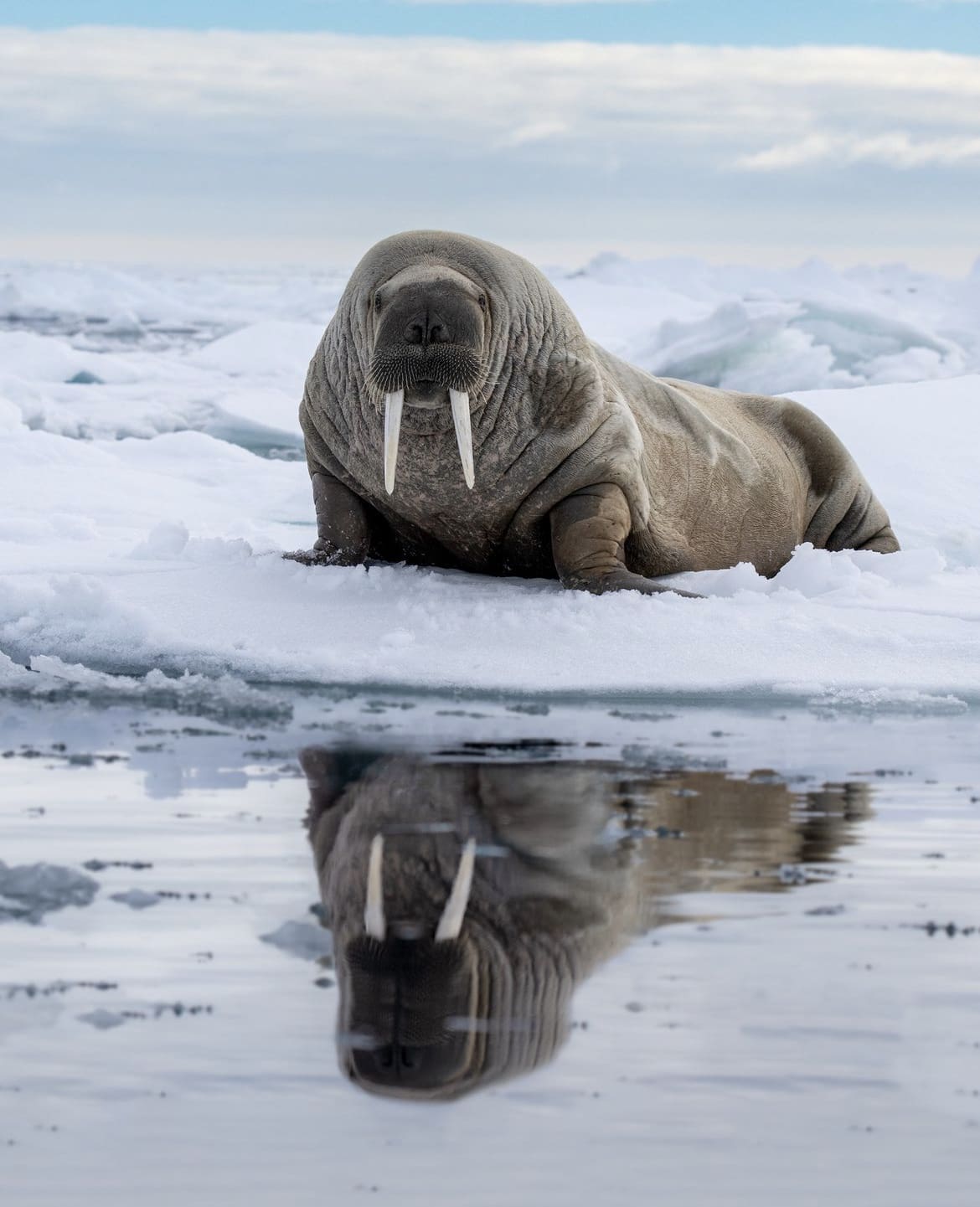
Walrus Skin
If you’ve ever wondered how walruses manage to thrive in the frigid Arctic waters without a constant need for hot cocoa and thermal blankets, the secret lies in their skin. Walrus skin is extraordinarily thick, up to 4 cm (1.6 inches) in some areas, acting as a natural wetsuit that guards against the cold and provides buoyancy in the water.
This isn’t your average skin, though; it’s tough, it’s rugged, and it’s designed to withstand the pressures of deep-sea diving and the occasional skirmish over territory or mates. But let’s not forget about the blubber beneath, a layer of fat that can be as thick as 15 cm (6 inches), offering additional insulation and energy storage.
In a world where the sun rarely shines, this blubber is the walrus’s built-in survival kit, keeping them warm and energized throughout the year.
Walrus Teeth
Now, onto one of the walrus’s most iconic features: their teeth. Well, not just any teeth—those magnificent tusks. These aren’t for chewing; they’re elongated canine teeth that can grow up to a meter (3 feet) long, serving as tools for survival rather than for culinary enjoyment. Walruses use their tusks for a variety of purposes, from hauling their massive bodies onto ice floes to establishing dominance and securing mates.
Imagine showing up to a date with a pair of meter-long tusks—talk about making an entrance! But it’s not all about show and tell; walruses also use their tusks to break through ice and access breathing holes, showcasing their practicality in the harsh Arctic environment.
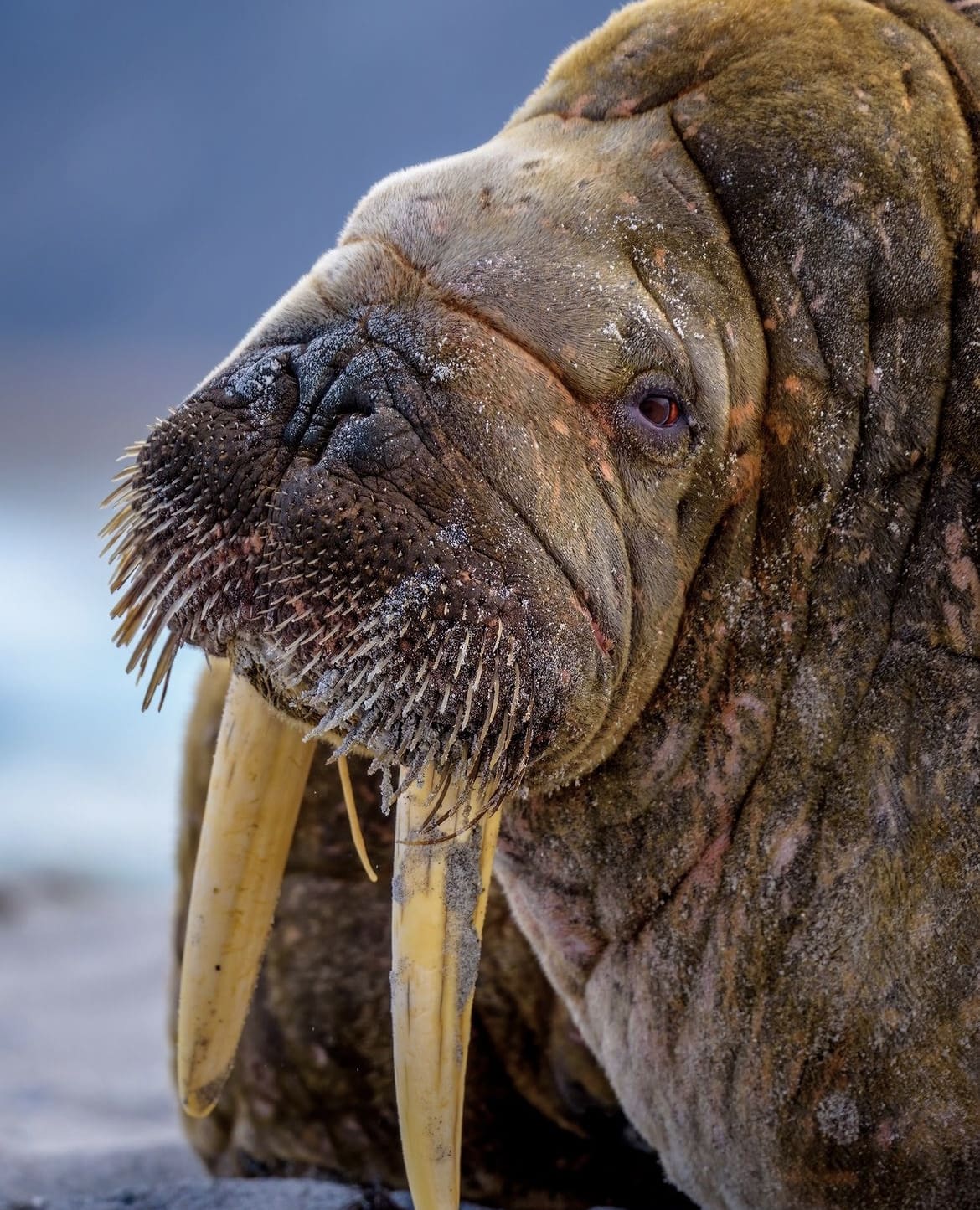
Walrus Colouration
When it comes to fashion, walruses might not be the first animals that come to mind, but they do have a unique sense of style—at least in terms of color. Walrus coloration varies from a dark brown to a pinkish hue, changing based on their age, the season, and their activities. Younger walruses tend to have darker skin, which lightens as they age.
But here’s where it gets interesting: walruses can appear almost pink when they’re warm because their blood vessels expand, bringing warm blood closer to the skin’s surface to release heat. It’s their natural way of cooling down, like flipping on the AC on a hot summer day. This color change is more than just a quirky trait; it’s a vital adaptation that helps walruses regulate their body temperature in the fluctuating Arctic climate.
What do Walruses Eat?
When it comes to dining, walruses have a surprisingly gourmet palette, preferring a diet that’s a bit more refined than the all-you-can-eat seafood buffet you might imagine. These creatures are bottom feeders, favoring a menu rich in benthic organisms like clams, mollusks, worms, and occasionally a slow-moving fish that didn’t get the memo to swim away.
Using their highly sensitive whiskers, walruses detect the slightest movements and textures in the dark ocean floor, uncovering their next meal with the precision of a seasoned forager. Once they’ve located their prey, they use a powerful suction, created by expelling air from their mouths, to vacuum the soft parts of their food right out of the shell. It’s efficient, it’s effective, and it’s a dining experience that’s uniquely walrus.
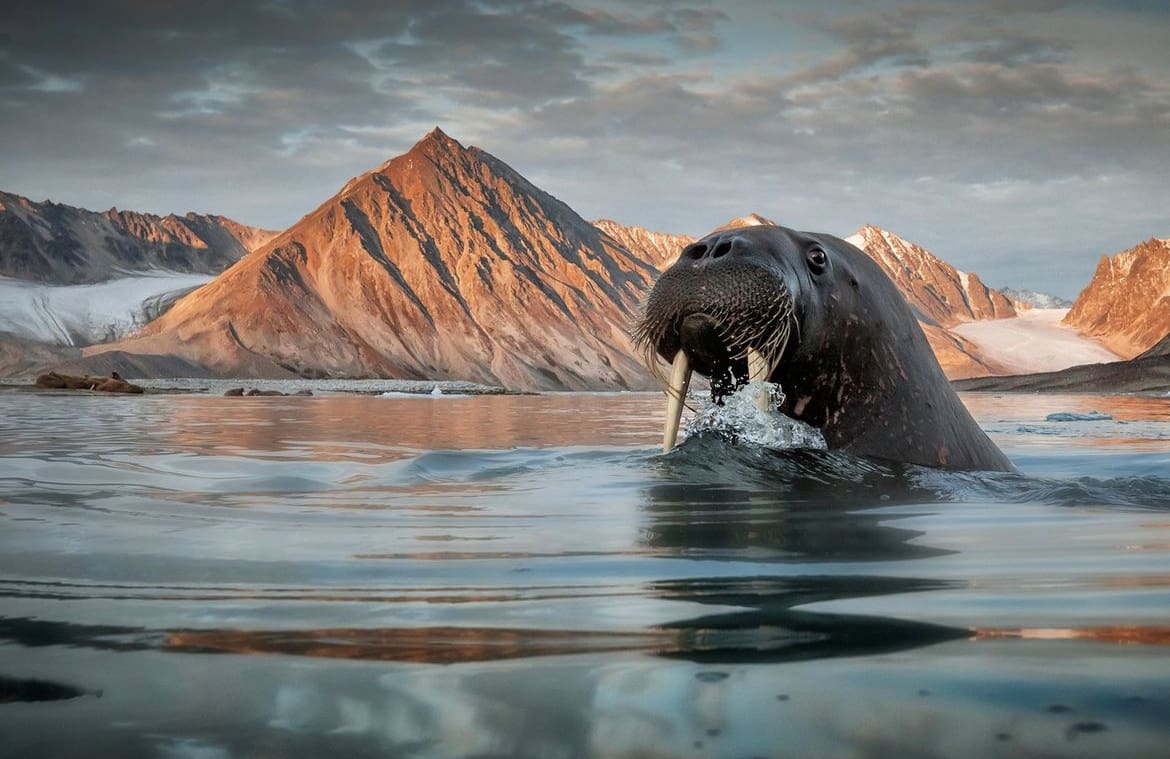
How do Walruses Hunt?
But how do these mammoth creatures manage to hunt so effectively in the vast, murky waters of the Arctic? Walruses rely on their exceptional diving skills, capable of plunging to depths of up to 100 meters (about 330 feet), though they usually prefer the shallower buffet tables available at around 10 to 50 meters deep.
These dives aren’t quick affairs; walruses can hold their breath for up to half an hour, giving them plenty of time to scour the ocean floor for delicacies. Their large size and thick blubber not only help them withstand the cold water but also aid in staying submerged, allowing them to walk along the seabed with a sort of ponderous grace.
It’s a hunt that requires patience, skill, and a bit of luck, proving that walruses are more than just big bodies with tusks—they’re skilled predators of the deep.
Walrus Social Structure
Now, onto the social lives of walruses, which are anything but solitary. Imagine the most happening beach party, and you’ve got a good picture of a walrus haul-out. These creatures are incredibly social, gathering in large groups, or herds, on ice floes and beaches, where they rest, socialize, and occasionally squabble over the best sunbathing spots. Within these groups, walruses form strong bonds, especially between mothers and calves, but also among adults.
They communicate with a range of vocalizations and physical cues, from grunts and bellows to more subtle gestures, maintaining a complex social network that’s vital for their survival. During the breeding season, this social structure shifts, as males become more competitive, vying for the attention of females with displays of strength, vocal contests, and, of course, showcasing those impressive tusks. It’s a dynamic social scene that’s as much about survival as it is about companionship in the cold Arctic waters.
@sciencechannel
How do Walruses Reproduce?
The walrus love scene is something straight out of an Arctic romance novel—if such a genre exists. It begins in the water, where males showcase their vocal talents, singing complex and hauntingly beautiful songs to attract females. These serenades can last for minutes, echoing under the icy waters. It’s not just about the voice, though. Males also engage in physical displays, brandishing their tusks to fend off rivals and prove their worthiness to potential mates.
Females, charmed by the song (and perhaps impressed by the display of tusks), mate with the strongest, most melodious suitors. After a gestation period that lasts over a year, including a several-months-long delayed implantation of the embryo, a single calf is born during the spring migration northward.
These calves are born ready for the water but remain closely guarded by their mothers, who are fiercely protective of their young. The bond between mother and calf is strong, with the calf relying on its mother’s rich milk for up to two years before fully transitioning to the gourmet benthic buffet below.
How Long do Walruses Live?
Walruses are among the Methuselahs of the marine world, boasting lifespans that can reach up to 40 years in the wild. Their longevity is a testament to their robustness and the tight-knit social structures that provide protection and support. However, life in the Arctic is not without its challenges.
Predation by polar bears and orcas, competition for food, and the ever-looming threat of climate change and its impact on sea ice habitats can cut these majestic lives short. Despite these challenges, the walrus’s ability to adapt and thrive in one of the harshest environments on Earth is truly remarkable.

Are Walruses Aggressive?
The walrus might have a face that only a mother could love, but does it have a temperament to match? Generally speaking, walruses are peaceful giants, preferring to spend their days lounging on ice with their closest friends and family. However, when it comes to protecting their territory or offspring, they don’t shy away from showing their might.
Male walruses can become particularly aggressive during mating season, when the competition for the attention of females heats up. Their large size and formidable tusks make them daunting adversaries, and they will use these natural weapons to establish dominance and fend off rivals. Despite this aggression, serious injuries are rare, as the displays are often more about showmanship than actual combat.
As for human interactions, walruses generally keep their distance. However, they can become aggressive if they feel threatened or cornered, especially if humans inadvertently come between them and the water—their escape route. As with any wild animal, it’s best to admire these magnificent creatures from a safe distance, respecting their space and their role in the Arctic ecosystem.
Are Walruses Territorial?
In the animal kingdom, where real estate often equals survival, you might wonder if walruses get feisty over their favorite ice floe or beach. While walruses do have preferred spots for hauling out and resting, they’re not territorial in the way some animals are. These creatures are social animals, and their haul-out sites are communal spaces where dozens, sometimes hundreds, of walruses gather.
However, don’t mistake this for a lack of personal space preferences. During the breeding season, males can get quite possessive—not over territory, but over the opportunity to mate. They establish temporary patches of sea as their own, where they court females with their enchanting underwater ballads.
It’s more about impressing the ladies and less about the patch of water itself. So, while you won’t see walruses fencing off their property, you might catch a glimpse of a sea serenade battle for breeding rights.
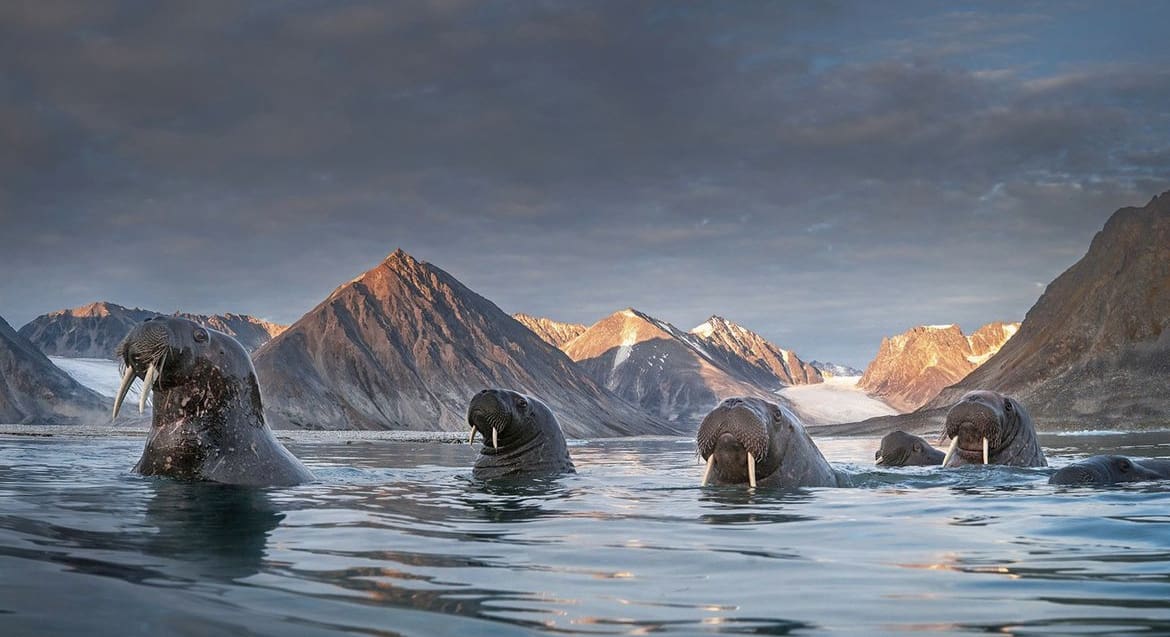
How Fast are Walruses?
You might not peg the walrus as a speed demon, and you’d be right—they’re not setting any aquatic speed records. But considering their size, walruses can hustle when they need to. In water, these bulky mammals are surprisingly graceful, capable of reaching speeds up to 35 km/h (about 22 mph) in short bursts when they’re motivated (think escaping predators or chasing after a particularly attractive mate).
However, their usual cruising speed is a more leisurely 4-6 km/h (2.5-3.7 mph), which is more in line with their laid-back lifestyle. On land, or rather, on ice, they’re much slower, lumbering along with the kind of effort you’d expect from someone wearing a suit made entirely of blubber. It’s in the water where they truly shine, showcasing a fluidity and agility that belies their cumbersome appearance.
Where do Walruses Live?
The walrus is an icon of the Arctic, where cold waters, ice, and an abundance of seafood make for a walrus paradise. They inhabit the Arctic Ocean and the northern seas off North America and Eurasia, with their distribution divided between the two subspecies: the Atlantic walrus and the Pacific walrus.
Atlantic walruses frequent the coastal areas from northeastern Canada to Greenland, dipping into the waters of the Arctic Ocean. Pacific walruses have a broader range, extending from the Bering Sea to the Chukchi Sea, and occasionally wandering into the Laptev Sea. Regardless of their address, walruses prefer shallow waters where they can easily dive to the ocean floor to forage for food, and ice floes or beaches that serve as rest stops and social clubs.
Their homes are dictated by the movement of sea ice, following it as it retreats north in the summer and returns south in the winter. This nomadic lifestyle ensures they always have access to their preferred feeding grounds and safe places to haul out, rest, and care for their young.
How Many Walruses are There in the Wild?
Quantifying the number of walruses in the wild is a bit like trying to count snowflakes during an Arctic blizzard—challenging, but not impossible. Recent estimates suggest that there are about 250,000 walruses worldwide, with the vast majority being Pacific walruses. The Atlantic walrus population is smaller, with estimates more difficult to come by due to their wider dispersion and the remote nature of their habitats.
These numbers, while seemingly robust, tell only part of the story. Walrus populations are subject to significant fluctuations due to a variety of factors, including predation, hunting, and, increasingly, changes in their environment due to climate change. Monitoring these populations is crucial for understanding the health of the species and the Arctic ecosystem at large.
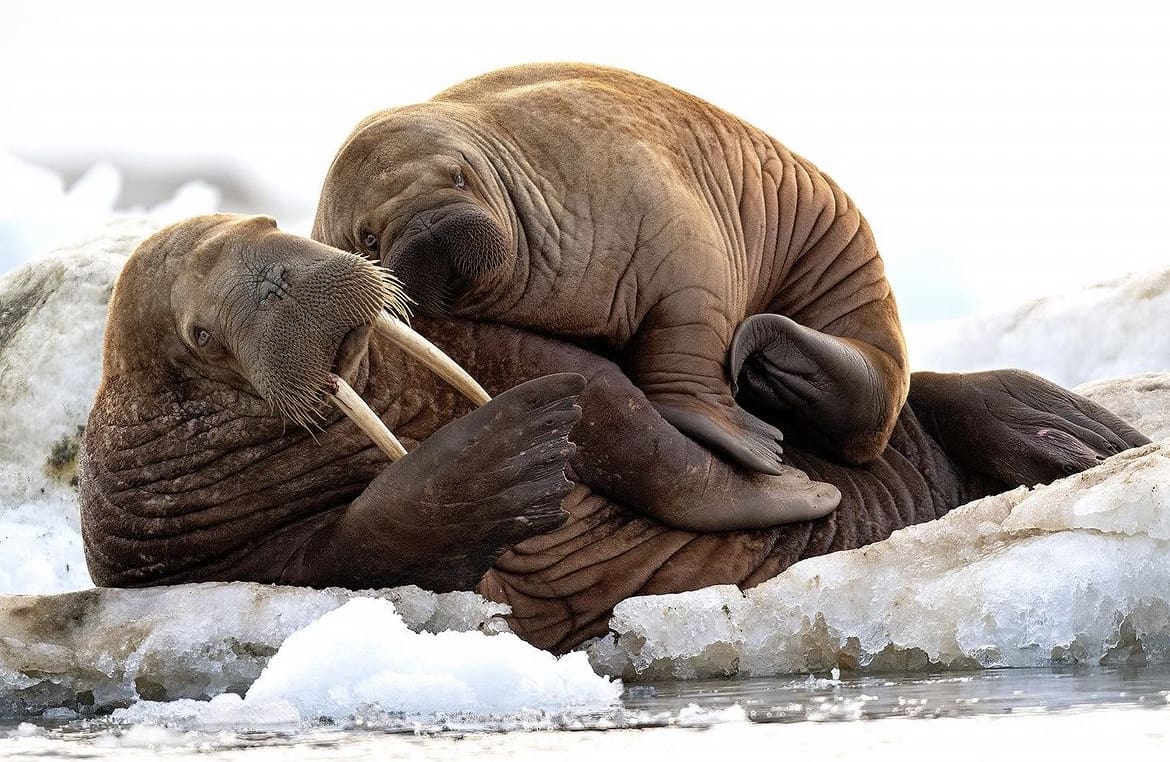
Are Walruses Endangered?
Currently, the walrus is not classified as endangered, but it does face a growing list of threats that could change its conservation status in the future. The most pressing of these is climate change, which is rapidly transforming the Arctic’s landscape. The reduction in sea ice, crucial for resting, breeding, and as a platform from which to forage, poses a significant threat to walrus populations. Without sufficient ice, walruses are forced to haul out on land, where they are more vulnerable to predation and human disturbance.
Additionally, walruses face threats from increased human activity in the Arctic, including shipping, oil and gas exploration, and hunting. While indigenous peoples have hunted walruses for thousands of years as part of a sustainable subsistence lifestyle, commercial hunting in the past has led to significant declines in some populations. Today, walrus hunting is regulated, but illegal hunting and the trade in walrus ivory still pose threats.
Threats to Walruses in the Wild
The challenges facing walruses in the wild are multifaceted and interlinked, with climate change at the heart of many of them. The loss of sea ice affects walruses directly by reducing their habitat and indirectly by impacting the abundance and distribution of their prey. As ice retreats, walruses are also pushed closer to human activities, increasing the risk of conflicts, disturbances, and accidental deaths.
Pollution is another concern. Contaminants in the water can accumulate in the walrus food chain, affecting their health and reproductive capabilities. Noise pollution from increased shipping and industrial activities can also disrupt walrus communication and behavior, further stressing these already vulnerable populations.
Conservation efforts are underway, aiming to address these threats through international cooperation, research, and policies designed to mitigate the impacts of climate change and human activities in the Arctic. Protecting the walrus and its habitat is not just about saving an iconic species; it’s about preserving the health and stability of the entire Arctic ecosystem.
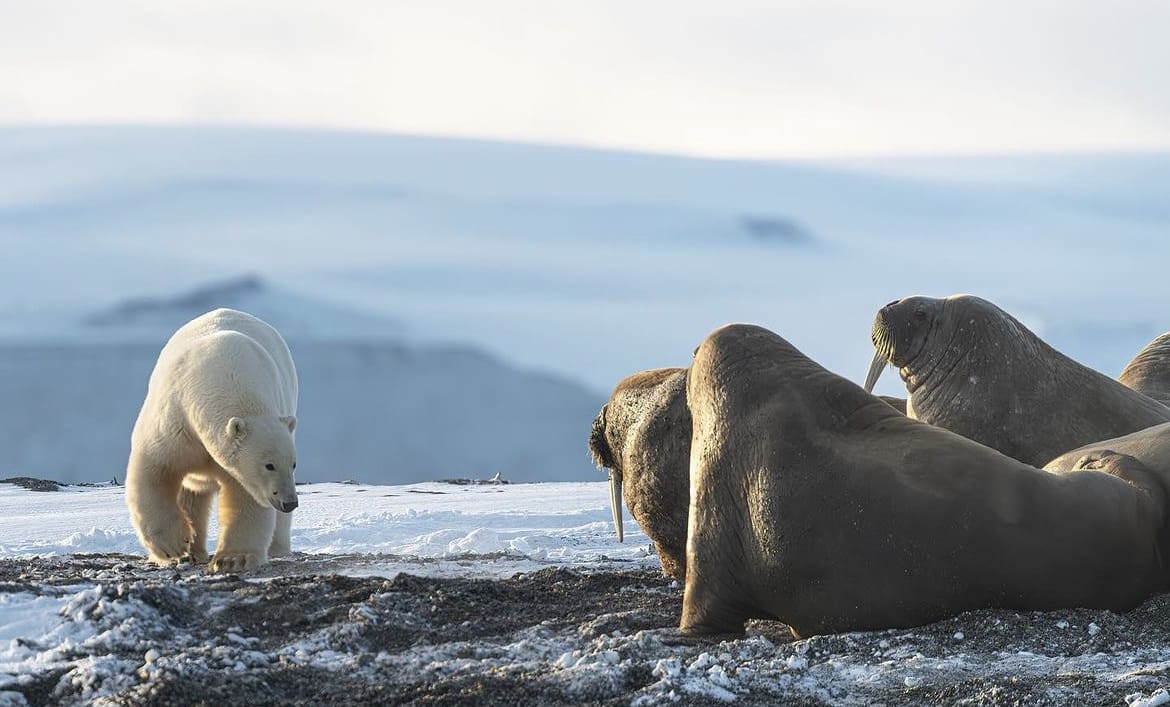
Where to See Walruses in the Wild
For those itching to see these Arctic giants up close (but not too close), there are several spots across the globe known for their walrus-watching opportunities. Remember, the key is to observe these creatures without disturbing their natural behaviors or habitats.
- Svalbard, Norway: This archipelago in the Arctic Ocean is famous for its diverse wildlife, including the walrus. Boat tours offer a chance to see walruses lounging on ice floes or beaches, particularly around the islands of Nordaustlandet and Edgeøya.
- Wrangel Island, Russia: A UNESCO World Heritage site, this remote island in the Chukchi Sea hosts large walrus gatherings. It’s a bit of a trek to get there, but it offers unparalleled opportunities to observe walruses in a relatively untouched environment.
- Round Island, Alaska, USA: Part of the Walrus Islands State Game Sanctuary, Round Island offers a unique chance to observe walruses during the summer months. Access is regulated to minimize disturbance, making it a responsible way to witness walrus gatherings.
- Baffin Island, Canada: The Canadian Arctic is home to both Pacific and Atlantic walruses. Boat tours and guided expeditions can bring you to spots where walruses are known to haul out, offering spectacular viewing opportunities.
Tips for Spotting Walruses
Observing walruses in their natural setting is an unforgettable experience, but it requires patience, respect, and a bit of know-how. Here are some tips to enhance your walrus-watching adventure:
- Keep Your Distance: Always maintain a respectful distance from walruses. Not only is this crucial for their safety and well-being, but it also prevents unnecessary stress on the animals.
- Use Binoculars or Zoom Lenses: To get a closer look without getting too close, bring binoculars or a camera with a good zoom lens. This way, you can observe detailed behaviors and characteristics from a safe distance.
- Stay Quiet and Calm: Loud noises and sudden movements can startle walruses. By staying quiet and calm, you minimize your impact on their natural behaviors.
- Follow Local Guidelines and Regulations: Different regions have specific rules designed to protect wildlife. Adhere to these guidelines to ensure your presence doesn’t negatively affect the walruses or their habitat.
- Choose Responsible Tour Operators: Support companies that practice ethical wildlife tourism. Look for operators that adhere to wildlife viewing guidelines and actively contribute to the conservation of the areas where they operate.

Facts about The Walrus
To round off our deep dive into the world of walruses, here are some bullet points that capture the essence and marvel of these Arctic behemoths:
- Communal Lounging: Walruses are known for their social nature, often found in large groups, snuggled up on ice or beaches.
- Musical Males: During mating seasons, male walruses showcase a range of vocal abilities, from deep, resonant bellows to high-pitched whistles, to woo potential mates.
- Whisker Wizardry: Their whiskers, or vibrissae, are incredibly sensitive, enabling walruses to detect prey in the murky depths of the ocean floor with remarkable precision.
Myths about The Walrus
Despite the fascination they inspire, several myths about walruses have floated around. Let’s set the record straight on a few:
- Tusks as Spears: It’s a common myth that walruses use their tusks to spear fish. In reality, they rely on a powerful suction mechanism to feed on soft-bodied sea creatures like mollusks.
- Lone Wanderers: Contrary to the belief that walruses prefer solitude, they are actually quite gregarious and enjoy the company of their fellow walruses, especially when it comes to resting and sunbathing.
- Ice Dependency: While it’s true walruses rely on sea ice for various activities, they are also adept at using land-based sites for resting, especially in areas where ice is seasonally absent or diminishing.
As we wrap up our exploration into the walrus’s existence, it’s evident that these creatures are not only fascinating subjects of study but also key players in the Arctic ecosystem. The journey through their world—from their social behaviors and unique feeding habits to debunking common myths—underscores the importance of understanding and protecting these magnificent marine mammals. Their survival and well-being are intrinsically tied to the health of the Arctic, highlighting the broader implications of conservation efforts in these critical habitats.
